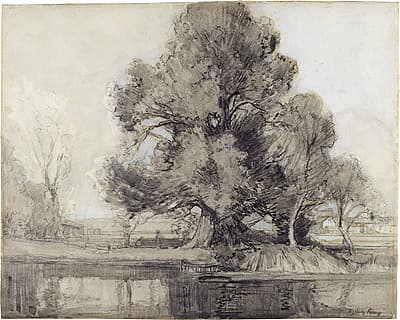
Sydney
LONG
Australia
1871
–
London
1955
England, Europe 1910-21; Australia 1921- 22; England 1922-25; Australia 1925-52; England from 1952
33.5 (h) x 42.0 (w) cm
signed ‘Sydney Long’ lower right Art Gallery of New South Wales, Sydney, purchased 1927
'… the river Wandel, the watercress beds, the swampy places, the market gardens, the cabbages and lavender ... the meadows plentifully adorned with advertisements and thinly sprinkled with horse and cow, but not lacking a rustic house and a shed or two, and to-day a show of plum-blossom ... The main part visible was twenty acres of damp meadow. On the left it was bounded by
the irregular low buildings of a laundry, a file and tool factory, and a chamois-leather mill ... On the far side a neat, white, oldish house was retiring amid blossoming fruit trees under the guardianship of several elms,
and the shadow of those two tall red chimneys of the Electricity Works …
A mixture of the sordid and the delicate in the whole was unmistakable.’ So wrote Edward Thomas, describing his journey along the River Wandle just before the First World War in In search of spring, the start: London to Guildford (1913).
The picture Thomas presents fits the scene Long created some 10 years later a land of lavender – and watercress. Like Long, Thomas was interested in describing the charms of the countryside, in introducing the natural world to those living in urban society.
Long made this drawing and the subsequent etching (cat 84) near the River Wandle around Mitcham, in the London Borough of Merton. Both watercress beds and lavender fields can be found there. There is a small oil painting of the same subject titled ‘Summer on the Wandle’ (private collection). This drawing is possibly a work Long sent back from England in 1913 titled ‘On the Wandle at Merton’.
'… the river Wandel, the watercress beds, the swampy places, the market gardens, the cabbages and lavender ... the meadows plentifully adorned with advertisements and thinly sprinkled with horse and cow, but not lacking a rustic house and a shed or two, and to-day a show of plum-blossom ... The main part visible was twenty acres of damp meadow. On the left it was bounded by
the irregular low buildings of a laundry, a file and tool factory, and a chamois-leather mill ... On the far side a neat, white, oldish house was retiring amid blossoming fruit trees under the guardianship of several elms,
and the shadow of those two tall red chimneys of the Electricity Works …
A mixture of the sordid and the delicate in the whole was unmistakable.’ So wrote Edward Thomas, describing his journey along the River Wandle just before the First World War in In search of spring, the start: London to Guildford (1913).
The picture Thomas presents fits the scene Long created some 10 years later a land of lavender – and watercress. Like Long, Thomas was interested in describing the charms of the countryside, in introducing the natural world to those living in urban society.
Long made this drawing and the subsequent etching (cat 84) near the River Wandle around Mitcham, in the London Borough of Merton. Both watercress beds and lavender fields can be found there. There is a small oil painting of the same subject titled ‘Summer on the Wandle’ (private collection). This drawing is possibly a work Long sent back from England in 1913 titled ‘On the Wandle at Merton’.
'… the river Wandel, the watercress beds, the swampy places, the market gardens, the cabbages and lavender ... the meadows plentifully adorned with advertisements and thinly sprinkled with horse and cow, but not lacking a rustic house and a shed or two, and to-day a show of plum-blossom ... The main part visible was twenty acres of damp meadow. On the left it was bounded by
the irregular low buildings of a laundry, a file and tool factory, and a chamois-leather mill ... On the far side a neat, white, oldish house was retiring amid blossoming fruit trees under the guardianship of several elms,
and the shadow of those two tall red chimneys of the Electricity Works …
A mixture of the sordid and the delicate in the whole was unmistakable.’ So wrote Edward Thomas, describing his journey along the River Wandle just before the First World War in In search of spring, the start: London to Guildford (1913).
The picture Thomas presents fits the scene Long created some 10 years later a land of lavender – and watercress. Like Long, Thomas was interested in describing the charms of the countryside, in introducing the natural world to those living in urban society.
Long made this drawing and the subsequent etching (cat 84) near the River Wandle around Mitcham, in the London Borough of Merton. Both watercress beds and lavender fields can be found there. There is a small oil painting of the same subject titled ‘Summer on the Wandle’ (private collection). This drawing is possibly a work Long sent back from England in 1913 titled ‘On the Wandle at Merton’.
